最新英语语法课课型试讲教案
- 格式:pdf
- 大小:28.30 KB
- 文档页数:3
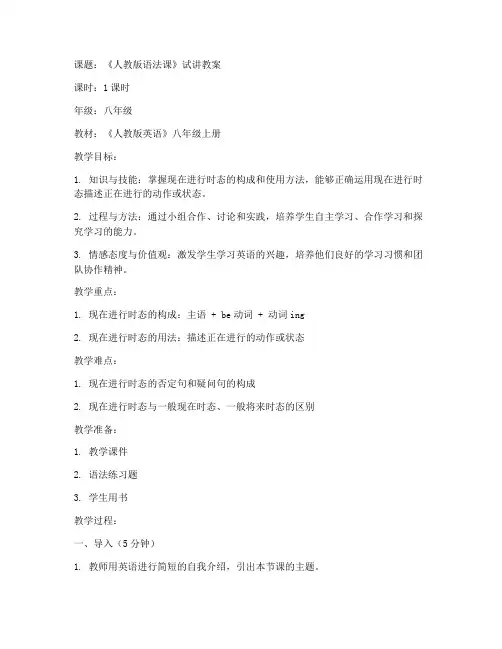
课题:《人教版语法课》试讲教案课时:1课时年级:八年级教材:《人教版英语》八年级上册教学目标:1. 知识与技能:掌握现在进行时态的构成和使用方法,能够正确运用现在进行时态描述正在进行的动作或状态。
2. 过程与方法:通过小组合作、讨论和实践,培养学生自主学习、合作学习和探究学习的能力。
3. 情感态度与价值观:激发学生学习英语的兴趣,培养他们良好的学习习惯和团队协作精神。
教学重点:1. 现在进行时态的构成:主语 + be动词 + 动词ing2. 现在进行时态的用法:描述正在进行的动作或状态教学难点:1. 现在进行时态的否定句和疑问句的构成2. 现在进行时态与一般现在时态、一般将来时态的区别教学准备:1. 教学课件2. 语法练习题3. 学生用书教学过程:一、导入(5分钟)1. 教师用英语进行简短的自我介绍,引出本节课的主题。
2. 提问学生:“What are you doing now?”(你现在在做什么?)让学生用一般现在时态回答。
二、新课讲授(20分钟)1. 介绍现在进行时态的构成:主语 + be动词(am/is/are)+ 动词ing。
2. 通过图片、视频等多媒体手段展示现在进行时态的用法。
3. 举例说明现在进行时态的肯定句、否定句和疑问句的构成。
4. 学生跟读例句,教师纠正发音。
三、小组活动(15分钟)1. 分组讨论:让学生用现在进行时态描述自己的日常生活。
2. 小组内互相纠正语法错误,互相学习。
3. 各小组派代表分享本组的讨论成果。
四、练习巩固(10分钟)1. 教师发放语法练习题,让学生独立完成。
2. 教师巡视课堂,指导学生解题。
3. 学生展示答案,教师点评。
五、总结与作业(5分钟)1. 教师对本节课所学内容进行总结,强调现在进行时态的构成和用法。
2. 布置课后作业:让学生用现在进行时态写一篇短文,描述周末的打算。
教学反思:1. 本节课通过多种教学方法,如图片、视频、小组讨论等,激发学生的学习兴趣,提高他们的英语学习积极性。
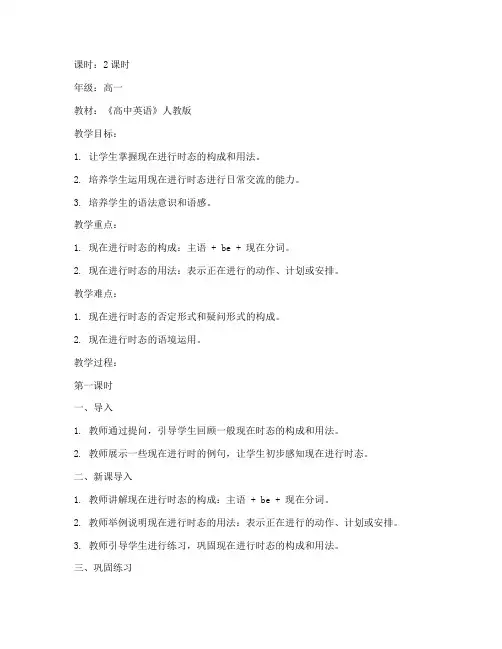
课时:2课时年级:高一教材:《高中英语》人教版教学目标:1. 让学生掌握现在进行时态的构成和用法。
2. 培养学生运用现在进行时态进行日常交流的能力。
3. 培养学生的语法意识和语感。
教学重点:1. 现在进行时态的构成:主语 + be + 现在分词。
2. 现在进行时态的用法:表示正在进行的动作、计划或安排。
教学难点:1. 现在进行时态的否定形式和疑问形式的构成。
2. 现在进行时态的语境运用。
教学过程:第一课时一、导入1. 教师通过提问,引导学生回顾一般现在时态的构成和用法。
2. 教师展示一些现在进行时的例句,让学生初步感知现在进行时态。
二、新课导入1. 教师讲解现在进行时态的构成:主语 + be + 现在分词。
2. 教师举例说明现在进行时态的用法:表示正在进行的动作、计划或安排。
3. 教师引导学生进行练习,巩固现在进行时态的构成和用法。
三、巩固练习1. 教师给出一些句子,让学生判断句子中的时态。
2. 教师给出一些句子,让学生将一般现在时态改为现在进行时态。
3. 教师给出一些句子,让学生将现在进行时态改为一般现在时态。
四、课堂小结1. 教师总结现在进行时态的构成和用法。
2. 学生分享学习心得。
第二课时一、复习1. 教师提问,检查学生对现在进行时态的掌握情况。
2. 学生回答问题,教师点评。
二、新课导入1. 教师讲解现在进行时态的否定形式和疑问形式的构成。
2. 教师举例说明现在进行时态的否定形式和疑问形式的用法。
三、巩固练习1. 教师给出一些句子,让学生判断句子中的时态。
2. 教师给出一些句子,让学生将一般现在时态改为现在进行时态的否定形式或疑问形式。
3. 教师给出一些句子,让学生将现在进行时态改为一般现在时态的否定形式或疑问形式。
四、课堂小结1. 教师总结现在进行时态的构成、用法、否定形式和疑问形式的构成。
2. 学生分享学习心得。
教学反思:1. 教师在教学过程中,注重引导学生进行实践,提高学生的语法意识和语感。
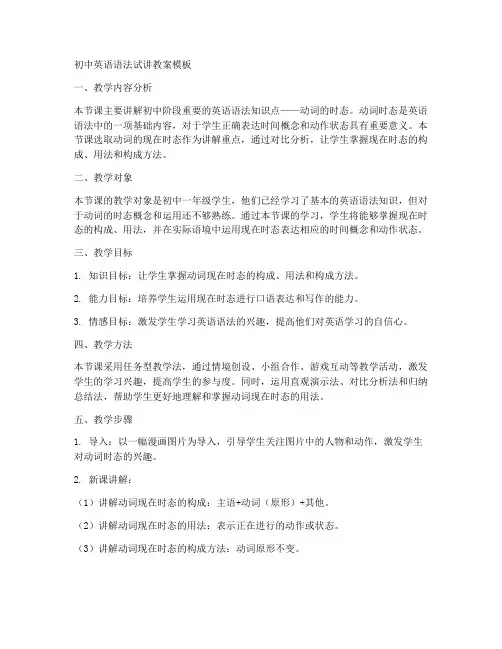
初中英语语法试讲教案模板一、教学内容分析本节课主要讲解初中阶段重要的英语语法知识点——动词的时态。
动词时态是英语语法中的一项基础内容,对于学生正确表达时间概念和动作状态具有重要意义。
本节课选取动词的现在时态作为讲解重点,通过对比分析,让学生掌握现在时态的构成、用法和构成方法。
二、教学对象本节课的教学对象是初中一年级学生,他们已经学习了基本的英语语法知识,但对于动词的时态概念和运用还不够熟练。
通过本节课的学习,学生将能够掌握现在时态的构成、用法,并在实际语境中运用现在时态表达相应的时间概念和动作状态。
三、教学目标1. 知识目标:让学生掌握动词现在时态的构成、用法和构成方法。
2. 能力目标:培养学生运用现在时态进行口语表达和写作的能力。
3. 情感目标:激发学生学习英语语法的兴趣,提高他们对英语学习的自信心。
四、教学方法本节课采用任务型教学法,通过情境创设、小组合作、游戏互动等教学活动,激发学生的学习兴趣,提高学生的参与度。
同时,运用直观演示法、对比分析法和归纳总结法,帮助学生更好地理解和掌握动词现在时态的用法。
五、教学步骤1. 导入:以一幅漫画图片为导入,引导学生关注图片中的人物和动作,激发学生对动词时态的兴趣。
2. 新课讲解:(1)讲解动词现在时态的构成:主语+动词(原形)+其他。
(2)讲解动词现在时态的用法:表示正在进行的动作或状态。
(3)讲解动词现在时态的构成方法:动词原形不变。
3. 实例分析:通过例句和练习,让学生对比分析现在时态和一般现在时的区别,加深学生对现在时态的理解。
4. 课堂练习:设计不同场景的练习题,让学生运用动词现在时态进行口语表达和写作。
5. 游戏互动:组织一个小组游戏,让学生在游戏中运用动词现在时态,增加课堂的趣味性。
6. 总结:对本节课的内容进行归纳总结,强调动词现在时态的构成、用法和构成方法。
7. 作业布置:布置相关的练习题,让学生巩固所学知识。
六、教学反思本节课结束后,教师应认真反思教学效果,针对学生的掌握情况,调整教学策略,以提高学生对动词现在时态的掌握程度。
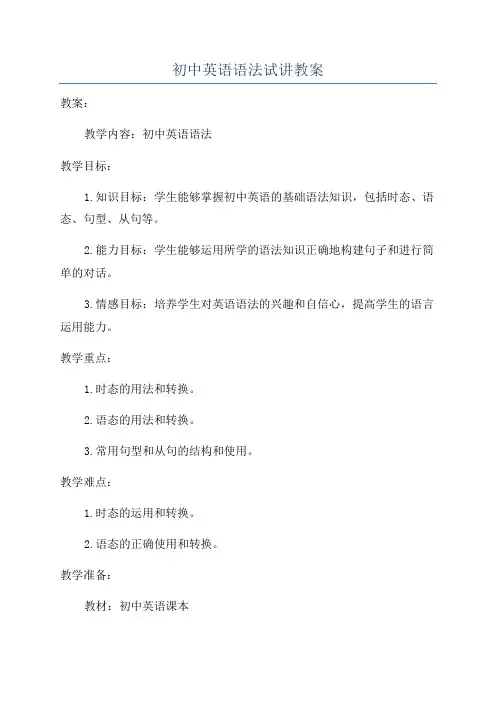
初中英语语法试讲教案教案:教学内容:初中英语语法教学目标:1.知识目标:学生能够掌握初中英语的基础语法知识,包括时态、语态、句型、从句等。
2.能力目标:学生能够运用所学的语法知识正确地构建句子和进行简单的对话。
3.情感目标:培养学生对英语语法的兴趣和自信心,提高学生的语言运用能力。
教学重点:1.时态的用法和转换。
2.语态的用法和转换。
3.常用句型和从句的结构和使用。
教学难点:1.时态的运用和转换。
2.语态的正确使用和转换。
教学准备:教材:初中英语课本教具:多媒体设备、教学演示素材:与时态、语态、句型相关的练习题、例句等。
教学过程:Step 1:导入新课1. GreetingT: Good morning, class!S: Good morning, teacher!T: How are you today?S: I'm fine, thank you. And you?T: I'm great, thank you! Are you ready for today's lesson?S: Yes, we are!2. RevisionT: Let's do a quick review. Can you tell me the past tense of the verb "run"?S: It's "ran".T: Good job! Now, what's the present perfect tense of the verb "eat"?S: It's "eaten".T: Excellent! You guys are doing great!Step 2:新知讲解1. Introduce the topic of grammar.T: Today, we are going to learn about grammar. Grammar is the structure or system of a language. It helps us to understand and use the language correctly. We will focus on tenses, voice, sentence patterns, and clauses. Let's get started!2. Present tensesa. Introduce the present simple tense.- Explain the usage and structure of present simple tense using examples.- Show the form of present simple tense: Subject + verb(s) + object.b. Introduce the present continuous tense.- Explain the usage and structure of present continuous tense using examples.- Show the form of present continuous tense: Subject + be verb (am/are/is) + verb-ing + object.3. Past tensesa. Introduce the past simple tense.- Explain the usage and structure of past simple tense using examples.- Show the form of past simple tense: Subject + past tense verb + object.b. Introduce the past continuous tense.- Explain the usage and structure of past continuous tense using examples.- Show the form of past continuous tense: Subject + past tense of be verb (was/were) + verb-ing + object.4. Future tensesa. Introduce the future simple tense.- Explain the usage and structure of future simple tense using examples.- Show the form of future simple tense: Subject + will + base form of verb + object.b. Introduce the future continuous tense.- Explain the usage and structure of future continuous tense using examples.- Show the form of future continuous tense: Subject + will be + verb-ing + object.5. Active and passive voicea. Introduce the active voice.- Explain the usage and structure of active voice using examples.- Show the form of active voice: Subject + verb + object.b. Introduce the passive voice.- Explain the usage and structure of passive voice using examples.- Show the form of passive voice: Object + be verb(am/are/is/was/were) + past participle (verb + ed) + by + subject.c. Practice exercises: Ask students to change the sentences from active voice to passive voice.Step 3:练习巩固1. Group work- Divide students into groups.- Monitor and assist students as they work.- Have groups share their answers and discuss any differences.2. Individual work- Students should work independently and submit their work when finished.- Review answers together as a class.Step 4:总结和回顾1. T: Now, let's summarize what we have learned today.- Review the different tenses, voice, sentence patterns, and clauses covered in the lesson.- Encourage students to ask any questions they may have.S: Goodbye, teacher! Thank you!。
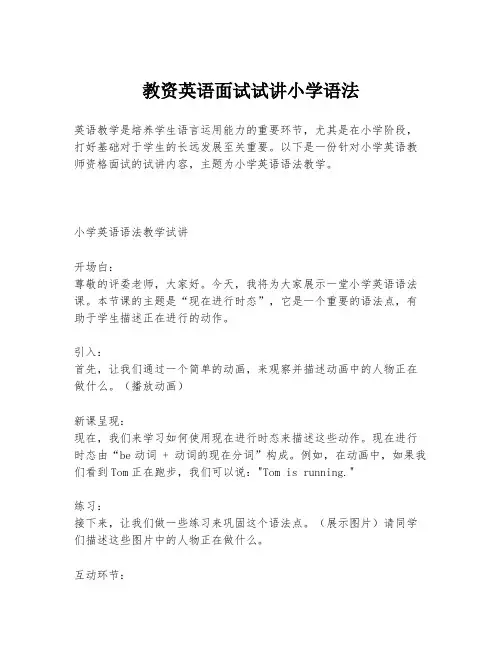
教资英语面试试讲小学语法英语教学是培养学生语言运用能力的重要环节,尤其是在小学阶段,打好基础对于学生的长远发展至关重要。
以下是一份针对小学英语教师资格面试的试讲内容,主题为小学英语语法教学。
小学英语语法教学试讲开场白:尊敬的评委老师,大家好。
今天,我将为大家展示一堂小学英语语法课。
本节课的主题是“现在进行时态”,它是一个重要的语法点,有助于学生描述正在进行的动作。
引入:首先,让我们通过一个简单的动画,来观察并描述动画中的人物正在做什么。
(播放动画)新课呈现:现在,我们来学习如何使用现在进行时态来描述这些动作。
现在进行时态由“be动词 + 动词的现在分词”构成。
例如,在动画中,如果我们看到Tom正在跑步,我们可以说:"Tom is running."练习:接下来,让我们做一些练习来巩固这个语法点。
(展示图片)请同学们描述这些图片中的人物正在做什么。
互动环节:现在,让我们进行一个小组活动。
每组同学选择一个场景,用现在进行时态来描述场景中的人物和动作。
完成后,每组轮流向全班展示。
巩固练习:为了确保大家都能掌握这个语法点,我们来做几个填空题。
(展示填空题)总结:通过今天的学习,希望大家能够熟练地使用现在进行时态来描述正在进行的动作。
记住,现在进行时态由“be动词 + 动词的现在分词”构成。
作业:作为今天的作业,请同学们观察自己家庭中的一个场景,并用现在进行时态写一个简短的段落描述这个场景。
结束语:感谢大家的积极参与,希望你们在今天的课堂上有所收获。
如果有任何问题,欢迎在课后与我讨论。
下课!请注意,这只是一个试讲内容的示例,实际的试讲需要根据学生的实际情况和教学目标进行调整。
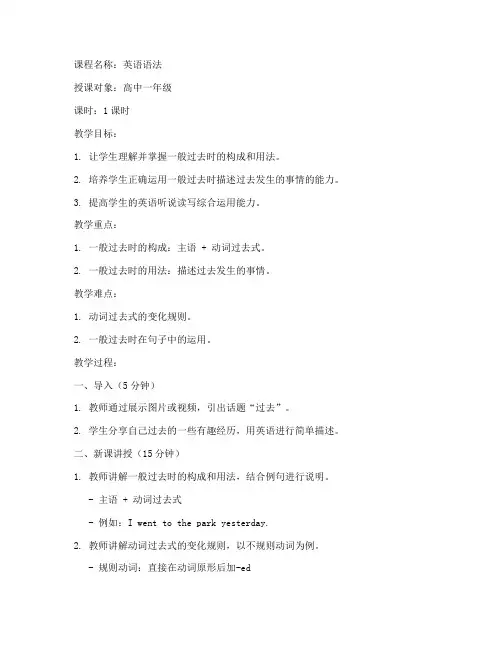
课程名称:英语语法授课对象:高中一年级课时:1课时教学目标:1. 让学生理解并掌握一般过去时的构成和用法。
2. 培养学生正确运用一般过去时描述过去发生的事情的能力。
3. 提高学生的英语听说读写综合运用能力。
教学重点:1. 一般过去时的构成:主语 + 动词过去式。
2. 一般过去时的用法:描述过去发生的事情。
教学难点:1. 动词过去式的变化规则。
2. 一般过去时在句子中的运用。
教学过程:一、导入(5分钟)1. 教师通过展示图片或视频,引出话题“过去”。
2. 学生分享自己过去的一些有趣经历,用英语进行简单描述。
二、新课讲授(15分钟)1. 教师讲解一般过去时的构成和用法,结合例句进行说明。
- 主语 + 动词过去式- 例如:I went to the park yesterday.2. 教师讲解动词过去式的变化规则,以不规则动词为例。
- 规则动词:直接在动词原形后加-ed- 不规则动词:需记忆特殊变化形式3. 教师展示一般过去时的句子,让学生判断正误。
- 例如:She is eating apples.(×)She ate apples.(√)三、巩固练习(15分钟)1. 学生完成课后练习题,巩固一般过去时的用法。
2. 教师挑选部分练习题进行讲解,纠正学生的错误。
四、课堂小结(5分钟)1. 教师总结本节课的学习内容,强调一般过去时的构成和用法。
2. 学生回顾本节课的重点内容,提出疑问。
五、课后作业(5分钟)1. 完成课后练习题。
2. 用一般过去时描述自己过去的一件有趣事情。
教学反思:1. 本节课通过图片、视频等多种教学手段,激发学生的学习兴趣。
2. 注重培养学生的英语听说读写综合运用能力,提高学生的英语水平。
3. 在讲解一般过去时变化规则时,应注重培养学生的记忆能力,提高学习效率。
微课设计:1. 使用PPT展示教学内容,图文并茂,便于学生理解。
2. 添加动画效果,提高课堂趣味性。
3. 针对不同知识点,设计练习题,检验学生的学习效果。
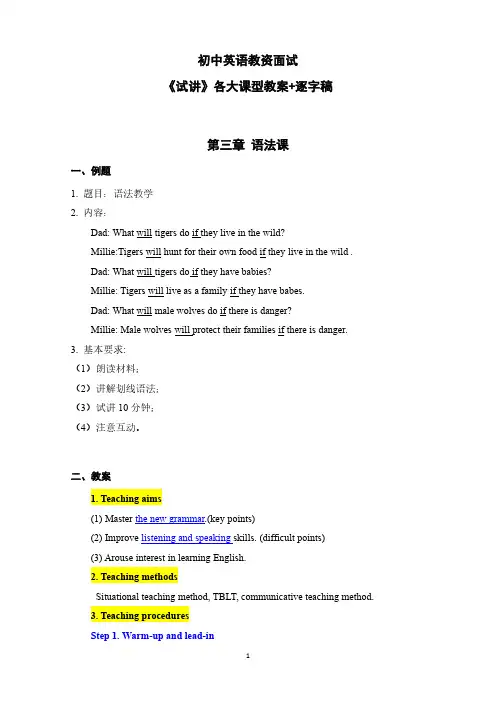
初中英语教资面试《试讲》各大课型教案+逐字稿第三章语法课一、例题1.题目:语法教学2.内容:Dad:What will tigers do if they live in the wild?Millie:Tigers will hunt for their own food if they live in the wild.Dad:What will tigers do if they have babies?Millie:Tigers will live as a family if they have babes.Dad:What will male wolves do if there is danger?Millie:Male wolves will protect their families if there is danger.3.基本要求:(1)朗读材料;(2)讲解划线语法;(3)试讲10分钟;(4)注意互动。
二、教案1.Teaching aims(1)Master the new grammar.(key points)(2)Improve listening and speaking skills.(difficult points)(3)Arouse interest in learning English.2.Teaching methodsSituational teaching method,TBLT,communicative teaching method.3.Teaching proceduresStep1.Warm-up and lead-in(1)Sing:<Monsters>.(2)Video:the documentary of BBC.(nature and animals on the earth;animals’behaviors)→Title:Tigers and wolvesStep2.Presentation(1)Find the main idea:What’s the conversation mainly about?(the life of tigers and wolves.)(2)Explain grammar knowledge:A.Show the sentences;B.Read and find similarities in groups.(The length of sentences is similar.)C.Conclude the grammar point:adverbial clause of condition.Step3.Practice(1)Fill in the blanks.(A.Tigers will hunt for their own food if they live in the wild.B.Tigers will live as a family if they have babes…)(2)Pass the ball.make a sentence with the grammar point.Step4.ProductionDiscussion:How about the behaviors of other animals?Step5.Summary and homework(1)Summary:adverbial clause of condition;we should protect nature and wild animals.(2)Homework:the adverbial clause of condition.4.Blackboard design三、逐字稿Step1.Warm-up and lead-inT:Class begins!Boys and girls,how are you today?Oh,you all look tired.Howabout singing a song to cheer up?Are you ready?Let's go!I see your monsters,I see your pain.Tell me your problems,I'll chase them away.I'll be your lighthouse,I'll make it okay.When I see your monsters,I'll stand there so brave,and chase them all away. OK,feel better now?Great,it’s time for class.(And,)At the beginning of the class,I’d like to show you a video.It's taken from the documentary of BBC.Please look at the screen.What can you see in the video?(手指屏幕)Do you know the answer?Yes,nature and animals on the earth.Any others?It tells about the wild animals'behaviors from different aspects and expand our knowledge. Excellent!You know so much about the video.Would you like to learn something more? (回答总结)Today,we are going to learn a new lesson—Tigers and wolves.(板书课题) Step2.PresentationGuys,please open your books.Now,I will show a short material for you.Listen carefully and think about the following question:What’s the conversation mainly about? Now,let's start.(停顿1~2s)(如有朗读要求,此处插入朗读文本)OK,stop here. Who can answer the question?The boy in glasses,you please.It is about the life of tigers and wolves.(复述答案)Agree?Well done!You got the correct answer.(反馈评价) Sit down,please!OK,boys and girls,it's time to learn something new.Here are some new sentences on the screen.(Tigers will hunt for their own food if they live in the wild.Tigers will live as a family if they have babes.Male wolves will protect their families if there is danger.)Now,boys and girls,Can you read these sentences together?Please look carefully and try to find the similarity of them.You can work in groups and share your ideas with each other.2minutes for you.(小组合作探究)Here we go....Stop here.OK!Who wants to be the volunteer?Jenny,you please!Yes,they all contain the word“will”and “if”.You have sharp eyes.Now,let's put all your views together.Look!This is what we will learn today.【名称】We can call it:Adverbial clause of condition.【名称】We use it to talk about the thing happens under certain conditions.For example,if you get up late,you will miss the train.【解释】We should remind that the main clause is the simple future tense and the subordinate clause is the simple present tense.【注意】Step3.PracticePractice makes perfect,so we will do some exercises.let’s“Fill in the blanks. Please finish it as quickly as you can and we will check the answers later.I would give you3minutes,here we go.(间隙中,简要板书出练习的题)Have you finished? What’s your answer,Cindy?Ok,Tigers will hunt for their own food if they live in the wild.Good,any different opinions?All right,but Cindy,please pay attention to the word“live”,not lives.Can you try again?Great,this time is better!Next one?Please tell me together.(Yes,Tigers will live as a family if they have babes.)Wonderful!After doing the exercises,you must be a little tired.Let’s play a game called“Pass the ball”.I will play a music,you should pass the ball to the student behind you,when I stop,who gets the ball should stand up and make a sentence with the grammar point (Adverbial clause of condition).Am I clear?Let's see who is lucky.Ready,go!You are my sunshine,my only sunshine....Stop!Jenny,you are so lucky.If I study hard,I will get good grades.Good.Let’s continue,You make me happy when skies are grey…John,it's your turn.If the weather is fine,I will go out to play basketball.Wow,you all did a very good job!Step4.ProductionSince we have mastered the knowledge well,now,let’s have a discussion.Think about the question:How about the behaviors of other animals?Try to use your imagination to think of more answers.You will work in groups and share your ideas with your group members.Don’t forget to use the grammer we just learned/(Don't forget to use what we just learned).(指向屏幕)You have5minutes.Here we go!(巡视+小提醒)Ok,you are you involved!Who wants to show your group ideas?Jack,you please!Wow,you know so many daily behaviors of different animals.You set a good example for us!(Any volunteers?The girl in the corner,please.Oh,you have good pronunciation and clear logic.)Sit down,please.Step5.Summary and homeworkHow time flies.Now let’s see what we have learned today.Yes,we have learned adverbial clause of condition,Excectly!(And we should protect nature and wild animals, right?Good!)After class,our homework is to search for more imformation about“adverbialclause of condition”on the Internet.Some of you will be invited to share it in the next class.So much for today,goodbye everyone!。
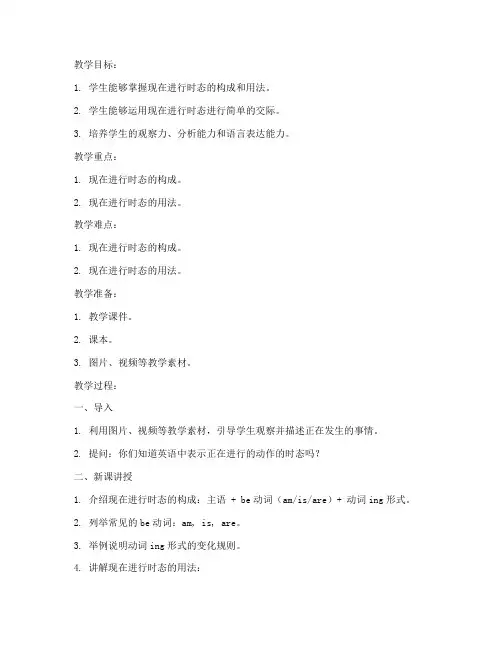
教学目标:1. 学生能够掌握现在进行时态的构成和用法。
2. 学生能够运用现在进行时态进行简单的交际。
3. 培养学生的观察力、分析能力和语言表达能力。
教学重点:1. 现在进行时态的构成。
2. 现在进行时态的用法。
教学难点:1. 现在进行时态的构成。
2. 现在进行时态的用法。
教学准备:1. 教学课件。
2. 课本。
3. 图片、视频等教学素材。
教学过程:一、导入1. 利用图片、视频等教学素材,引导学生观察并描述正在发生的事情。
2. 提问:你们知道英语中表示正在进行的动作的时态吗?二、新课讲授1. 介绍现在进行时态的构成:主语 + be动词(am/is/are)+ 动词ing形式。
2. 列举常见的be动词:am, is, are。
3. 举例说明动词ing形式的变化规则。
4. 讲解现在进行时态的用法:a. 表示正在进行的动作。
b. 表示正在发生的动作。
c. 表示按计划或安排即将发生的动作。
三、课堂练习1. 完成课本上的练习题,巩固所学知识。
2. 根据所学内容,用现在进行时态描述以下场景:a. 在教室里。
b. 在公园里。
c. 在电影院里。
四、小组讨论1. 将学生分成小组,讨论以下问题:a. 现在进行时态与一般现在时态的区别。
b. 现在进行时态在日常生活中的应用。
2. 每组选派一名代表进行发言。
五、总结1. 回顾本节课所学内容,强调现在进行时态的构成和用法。
2. 布置课后作业,巩固所学知识。
教学反思:本节课通过图片、视频等教学素材,激发学生的学习兴趣,让学生在轻松愉快的氛围中学习现在进行时态。
在课堂练习和小组讨论环节,学生积极参与,提高了他们的观察力、分析能力和语言表达能力。
在教学过程中,应注意以下几点:1. 注重学生的主体地位,鼓励学生主动参与课堂活动。
2. 结合实际生活,引导学生运用所学知识进行交际。
3. 及时发现学生的学习困难,给予针对性的指导。
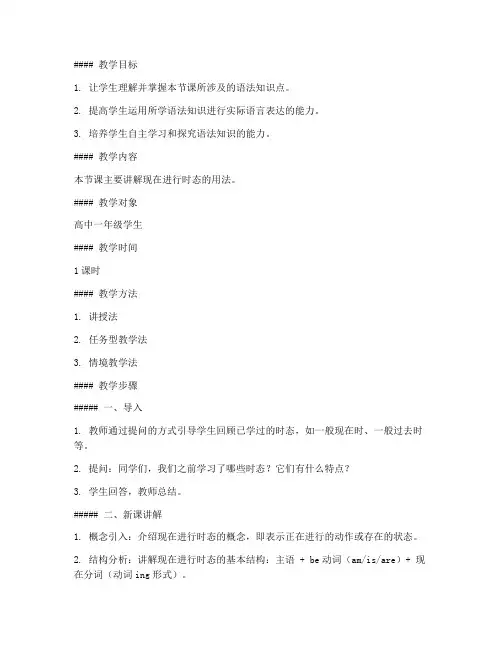
#### 教学目标1. 让学生理解并掌握本节课所涉及的语法知识点。
2. 提高学生运用所学语法知识进行实际语言表达的能力。
3. 培养学生自主学习和探究语法知识的能力。
#### 教学内容本节课主要讲解现在进行时态的用法。
#### 教学对象高中一年级学生#### 教学时间1课时#### 教学方法1. 讲授法2. 任务型教学法3. 情境教学法#### 教学步骤##### 一、导入1. 教师通过提问的方式引导学生回顾已学过的时态,如一般现在时、一般过去时等。
2. 提问:同学们,我们之前学习了哪些时态?它们有什么特点?3. 学生回答,教师总结。
##### 二、新课讲解1. 概念引入:介绍现在进行时态的概念,即表示正在进行的动作或存在的状态。
2. 结构分析:讲解现在进行时态的基本结构:主语 + be动词(am/is/are)+ 现在分词(动词ing形式)。
3. 举例说明:展示多个例句,让学生理解现在进行时态的用法。
- 例句1:I am reading a book.- 例句2:She is watching TV.- 例句3:They are playing football.4. 注意事项:讲解现在进行时态的常见错误和注意事项,如be动词的人称和数的变化、现在分词的构成等。
##### 三、任务型教学1. 小组活动:将学生分成小组,要求每个小组用现在进行时态造句,并相互检查。
2. 角色扮演:请学生扮演不同的角色,用现在进行时态进行对话练习。
##### 四、巩固练习1. 填空练习:教师给出句子,让学生填入正确的现在进行时态。
2. 翻译练习:将中文句子翻译成英文,要求使用现在进行时态。
##### 五、总结1. 教师总结本节课所学内容,强调现在进行时态的用法和注意事项。
2. 学生回顾所学知识,提出疑问。
##### 六、作业布置1. 完成课后练习题。
2. 用现在进行时态写一篇短文。
#### 教学反思1. 教师在教学过程中应关注学生的参与度和学习效果,及时调整教学策略。
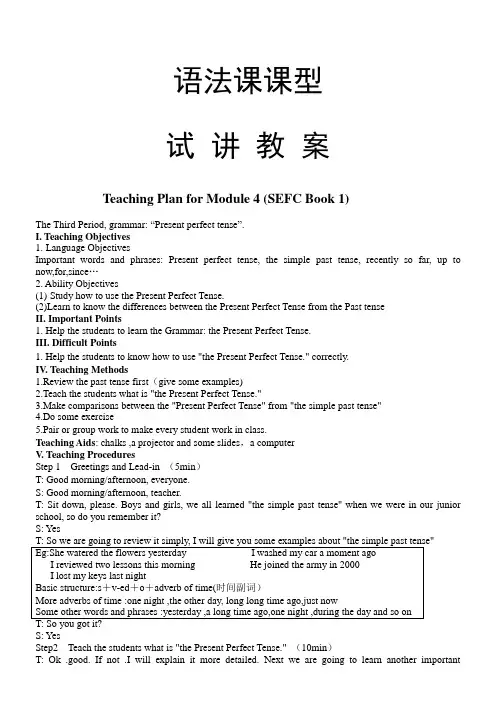
语法课课型试讲教案Teaching Plan for Module 4 (SEFC Book 1)The Third Period, grammar:“Present perfect tense”.I. Teaching Objectivesnguage ObjectivesImportant words and phrases: Present perfect tense, the simple past tense, recently so far, up to now,for,since…2. Ability Objectives(1)Study how to use the Present Perfect Tense.(2)Learn to know the differences between the Present Perfect Tense from the Past tenseII. Important Points1. Help the students to learn the Grammar: the Present Perfect Tense.III. Difficult Points1. Help the students to know how to use "the Present Perfect Tense." correctly.IV. Teaching Methods1.Review the past tense first(give some examples)2.Teach the students what is "the Present Perfect Tense."3.Make comparisons between the "Present Perfect Tense" from "the simple past tense"4.Do some exercise5.Pair or group work to make every student work in class.Teaching Aids: chalks ,a projector and some slides,a computerV. Teaching ProceduresStep 1 Greetings and Lead-in (5min)T: Good morning/afternoon, everyone.S: Good morning/afternoon, teacher.T: Sit down, please. Boys and girls, we all learned "the simple past tense" when we were in our junior school, so do you remember it?S: YesT: So we are going to review it simply, I will give you some examples about "the simple past tense" Eg:She watered the flowers yesterday I washed my car a moment agoI reviewed two lessons this morning He joined the army in 2000I lost my keys last nightBasic structure:s+v-ed+o+adverb of time(时间副词)More adverbs of time :one night ,the other day, long long time ago,just nowSome other words and phrases :yesterday ,a long time ago,one night ,during the day and so onS: YesStep2 Teach the students what is "the Present Perfect Tense."(10min)grammar--the Present Perfect Tense (analysis sentences)I have spent all of my money He already finished his homeworkHe has been ill for a long time She has lived in Beijing for 10 yearsHave you had your lunch?more words and phrases:so far,ever,up to now ,just,recently,yet,before and so on.T: Who can tell me what tense I used in the sentences?S: I can. It is the Present Perfect Tense.T: Right. Let’s look at these sentences.(Show them on the screen.)1. I’ve seen quite a lot of China.2. I’ve visited some beautiful cities.3. He’s just completed it.4. They’ve put up a lot of high-rise buildings recently.5. A friend has told me about a nice little fish restaurant here.6. It has been six years since we last saw each other, you know.(First, get the students to discuss and compare these sentences. Then the teacher discuss with them.)T: Let’s look at the first sentence. Do we know when the speaker saw these places?S: No, we don’t.T: Right. The second. Do we know when the speaker visited these cities?S: No, we don’t.T: Good. The third one. Is this a recent event?S: Yes, it is.T: The fourth. Did they do this a long time ago?S: No, they didn’t.T: The fifth. Did this happen recently?S: Yes, it did.T: Very good. The last one. When was the last time that the speaker saw his friend?S: 6 years ago.T: Wonderful! Now we know when we can use the Present Perfect Tense.(If necessary, give more examples and explanations.)for and sincefor+时间段eg:I have lived in this city for more than 40 years I have waited for you for two hourssince+时间点/过去时的句子It is/has been +时间段+since+时间点/过去时的句子He has been here since 1998 It is five years since he got marriedStep III Excises (10min)Complete these sentences with the words in the box use either the past simple tense or the present perfect tense.built buy come get live see stay visit1. They _________ many high-rise buildings in the city.2. The traffic in the city_________ much worse recently.3. When the tourists _________ in the summer, they _________ in the city center.4. Xiamen is one of the most attractive cities John_________.5. Xiao Li _________ in Xiamen all his life.6. John _________ (not) any presents yet but he _________ a shopping mall, where they will go tomorrow.(Ask the students to answer the questions, first individually, then compare their answers in pairs andcheck the answers with the whole class.)Suggested answers:1.have built2.has got3.came,stayed4.has visited5.has lived6.has not bought, has seenPracticeT: Now please write down some interesting places that you have been to. Work in pairs and tell each other about the places. Requirement:your contents must include" the present perfect tense" and" the past simple tense"Possible answer:A: I have been to Shanghai, Tianjin, Dalian, Nanjing and Xuzhou.B: When did you go to Dalian?A: I went there last year.B: What was it like?A: It’s very beautiful. Have you been there?B: No, I haven’t.Step V Summary (5min)this class we have learned something important about " the Present Perfect Tense".such as it's usage and basic structure.we also know the differences about "the Present Perfect Tense"and the Past Tense" what's more,we should pay more attention to the words"for" and "since"Step VI Homework Assignment(2min).review what we learned this class and finish the exercises on your workbookpreview the grammar 2 on your textbook page 36VI. Blackboard Design(1) Important words and phrases: the simple past tense the Present Perfect Tense .recently so far, up to now...(2) Important sentence patterns:for+时间段1It is/has been +时间段+since+时间点/过去时的句子Lesson 4, Unit 1A Social Survey—My Neighborhood(The Third Period: “Present perfecttense”)1. Review the simple tense simply2.Introduce and teach the PresentPerfect Tense3. Compare the simple tense and thePresent Perfect Tense4 .Excises5. Simple summaryHomework:.review what welearned this class andfinish the exerciseson your workbookpreview the grammar 2on your textbook page36。
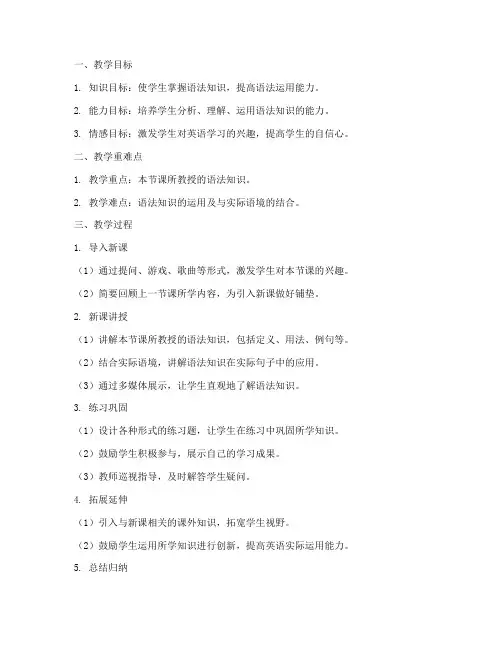
一、教学目标1. 知识目标:使学生掌握语法知识,提高语法运用能力。
2. 能力目标:培养学生分析、理解、运用语法知识的能力。
3. 情感目标:激发学生对英语学习的兴趣,提高学生的自信心。
二、教学重难点1. 教学重点:本节课所教授的语法知识。
2. 教学难点:语法知识的运用及与实际语境的结合。
三、教学过程1. 导入新课(1)通过提问、游戏、歌曲等形式,激发学生对本节课的兴趣。
(2)简要回顾上一节课所学内容,为引入新课做好铺垫。
2. 新课讲授(1)讲解本节课所教授的语法知识,包括定义、用法、例句等。
(2)结合实际语境,讲解语法知识在实际句子中的应用。
(3)通过多媒体展示,让学生直观地了解语法知识。
3. 练习巩固(1)设计各种形式的练习题,让学生在练习中巩固所学知识。
(2)鼓励学生积极参与,展示自己的学习成果。
(3)教师巡视指导,及时解答学生疑问。
4. 拓展延伸(1)引入与新课相关的课外知识,拓宽学生视野。
(2)鼓励学生运用所学知识进行创新,提高英语实际运用能力。
5. 总结归纳(1)对本节课所学内容进行总结,让学生回顾所学知识。
(2)强调语法知识的重要性,鼓励学生在日常生活中多加运用。
四、教学评价1. 课堂表现:观察学生在课堂上的学习态度、参与程度等。
2. 作业完成情况:检查学生对课堂所学知识的掌握程度。
3. 课堂练习:评估学生在课堂练习中的表现。
五、教学反思1. 教学过程中,关注学生的学习需求,调整教学策略。
2. 鼓励学生积极参与,提高课堂氛围。
3. 及时反馈,关注学生进步,激发学习兴趣。
以下为具体教案示例:教案名称:高中英语语法《现在进行时》一、教学目标1. 知识目标:使学生掌握现在进行时的构成、用法及意义。
2. 能力目标:培养学生运用现在进行时描述正在发生的动作的能力。
3. 情感目标:激发学生对英语学习的兴趣,提高学生的自信心。
二、教学重难点1. 教学重点:现在进行时的构成、用法及意义。
2. 教学难点:现在进行时在句子中的运用及与一般现在时的区别。
课程名称:初中英语语法年级:八年级课题:《一般过去时》教学目标:1. 知识目标:学生能够掌握一般过去时的构成和用法,能够正确使用过去时态的动词形式。
2. 能力目标:学生能够运用一般过去时描述过去发生的事情,提高语言表达能力。
3. 情感目标:培养学生对英语学习的兴趣,增强自信心,激发学习动力。
教学重点:1. 一般过去时的构成:动词的过去式形式。
2. 一般过去时的用法:用于描述过去发生的事情。
教学难点:1. 动词过去式的变化规则。
2. 一般过去时与现在、将来时态的区分。
教学过程:一、导入1. 教师通过图片、视频或故事等形式,引出过去发生的事情,激发学生的学习兴趣。
2. 提问:你们有没有经历过一些有趣的事情?用英语描述一下。
二、新课讲解1. 教师讲解一般过去时的构成:动词的过去式形式。
- 规则变化:以-y结尾的动词,去掉-y后加-ed;以辅音字母结尾的动词,末尾加-ed;以重读闭音节结尾的动词,末尾加-ed。
- 不规则变化:be动词过去式为was/were;have/has的过去式为had;do/does的过去式为did。
2. 教师通过例句讲解一般过去时的用法:- 描述过去发生的事情:I watched a movie last night.- 表达过去经常发生的事情:He used to play football every weekend.3. 学生跟读、模仿,练习一般过去时的用法。
三、练习1. 教师布置练习题,让学生在课堂上完成,巩固所学知识。
2. 学生分组讨论,互相检查练习题答案。
四、课堂小结1. 教师总结本节课所学内容,强调一般过去时的构成和用法。
2. 学生回顾本节课所学,提出疑问。
五、作业布置1. 完成课后练习题。
2. 用一般过去时描述一个自己经历的有趣事情。
教学反思:本节课通过图片、视频、故事等多种形式,激发学生的学习兴趣,使学生能够轻松掌握一般过去时的构成和用法。
在教学过程中,教师注重学生的参与,鼓励学生积极发言,提高课堂互动性。
课程名称:高中英语语法授课对象:高中一年级学生课时安排: 1课时教学目标:1. 知识目标:掌握所讲语法点的概念、用法及典型例句。
2. 能力目标:提高学生运用所学语法知识进行交际的能力。
3. 情感目标:激发学生学习英语的兴趣,培养学生良好的学习习惯。
教学重点:本节课所讲语法点的概念和用法。
教学难点:本节课所讲语法点的灵活运用。
教学准备:1. 教师准备:PPT课件、语法练习题、实物或图片等教学辅助材料。
2. 学生准备:预习所讲语法点,准备与语法点相关的例句。
教学过程:一、导入新课(5分钟)1. 利用图片、视频或实物导入,激发学生学习兴趣。
2. 提问:同学们,你们知道今天我们要学习什么语法点吗?简单介绍本节课所讲语法点。
二、讲解新课(25分钟)1. 讲解语法点的概念,结合例句进行分析。
2. 展示PPT课件,详细讲解语法点的用法,包括时态、语态、非谓语动词等。
3. 结合实物或图片,让学生进行实际操作,加深对语法点的理解。
三、课堂练习(15分钟)1. 分组练习,让学生运用所学语法点进行交际。
2. 教师巡视指导,纠正学生的错误。
四、课堂小结(5分钟)1. 回顾本节课所讲语法点,强调重点和难点。
2. 布置课后作业,巩固所学知识。
五、课后作业1. 完成课后练习题,巩固所学语法点。
2. 搜集与所学语法点相关的例句,进行积累。
教学反思:1. 本节课的教学效果如何?2. 学生对所讲语法点的掌握程度如何?3. 教学过程中有哪些不足之处?4. 如何改进教学方法,提高教学效果?板书设计:高中英语语法试讲教案模板课程名称:高中英语语法授课对象:高中一年级学生课时安排: 1课时教学目标:1. 知识目标:掌握所讲语法点的概念、用法及典型例句。
2. 能力目标:提高学生运用所学语法知识进行交际的能力。
3. 情感目标:激发学生学习英语的兴趣,培养学生良好的学习习惯。
教学重点:本节课所讲语法点的概念和用法。
教学难点:本节课所讲语法点的灵活运用。
小学英语语法试讲教案【篇一:小学英语试讲教案1】下面附上我所写的教案中的教学过程:story —— jenny goes to citystep 1. greetings(1) good morning/ how are you.(2) whos on duty today?step 2.revision(1)拿不同颜色的粉笔,进行一一提问,对答对的学生,给予掌声,呈上真诚的目光,并奖励一个小红花。
what colour was it?it‘s red/green/blue/yellow(2)做游戏what’s missing?its... ...教师从不同颜色粉笔中,随意抽出一支,问学生少了哪一颜色,带动学生学习兴趣,活跃课堂气氛。
促使学生们所学单词掌握的更牢固更准确!step 3.freetalksdo you like shopping?这个话题学生比较熟悉,贴近生活,纷纷举手发言,从中引入教学,培养学生创造性思维能力。
step 4.teaching1)提出2个问题,让学生们带着问题去看故事短文,时间定为10分钟jenny:how to go to the city?why she doesnt... ...?再这10分钟学生阅读期间,老师写好一部分板书.2)针对提出的2个问题,展开讨论,回答问题,并及时给予学生答案的指导3)放3遍磁带短文录音,让学生们大声地去跟读4)再针对故事短文中4个角色,找四名学生,进行分角色朗读课文.最后并予以掌声,给予肯定和奖励5)教师把故事短文分为4部分,设置情景,进行逐一翻译,易于学生理解6)针对故事短文的知识点,一一讲解分析,例have to do sth最好做某事句型,并及时做好板书,时刻促使学生看黑板,培养注意力不分散7)情景再现,将学生分组,找四名同学,分别带上面具,试着扮演短文中四个角色,jenny jennys mather jennys mother denny,让学生们身临其境,去领悟故事短文中意思,掌握交际中的技巧和方法,挖掘学生们运用语言的创造能力step 5.homework培养听说读写能力1)listen the story 循环放短文听录音2)read the story again and again 大声一遍遍朗读短文3)write the story 正确抄写短文4)remember knowledge on class掌握牢记课上所学知识【篇二:小学英语教案模板汇编(全册精选)】小学英语教案模板汇编(全册精选)【对于英语学科专业在事业单位教师、普岗教师、昆明教师、特岗教师面试说课或试或教师资格试讲中,到底是使用全英文的,还是可以使用汉语的,是所有考试面试的学生所纠结的一个问题,育萃面试为您提供了不同的案例。
课程名称:英语语法授课年级:八年级授课课时:1课时教学目标:1. 知识目标:学生能够掌握现在进行时态的构成和用法。
2. 能力目标:学生能够运用现在进行时态进行日常交流,描述正在进行的动作或活动。
3. 情感目标:培养学生对英语学习的兴趣,提高学生的语言运用能力。
教学重点:1. 现在进行时态的构成:be + 动词的现在分词形式。
2. 现在进行时态的用法:描述正在进行的动作或活动。
教学难点:1. 现在进行时态的构成和用法。
2. 在实际交流中正确运用现在进行时态。
教学准备:1. 多媒体课件2. 语法练习题3. 图片或视频素材教学过程:一、导入(5分钟)1. 通过提问或图片展示,引导学生回顾过去时态和一般现在时态的用法。
2. 提出本节课要学习的语法点:现在进行时态。
二、新课讲授(20分钟)1. 介绍现在进行时态的构成:be + 动词的现在分词形式。
2. 通过例句讲解现在进行时态的用法,如:- I am reading a book.- She is watching TV.- They are playing football.3. 展示一些现在进行时态的例句,让学生跟读并模仿。
4. 通过图片或视频展示不同的场景,让学生用现在进行时态描述正在发生的事情。
三、练习巩固(15分钟)1. 进行小组活动,让学生用现在进行时态描述图片或视频中的场景。
2. 进行语法填空练习,巩固现在进行时态的构成和用法。
3. 学生互相检查练习答案,教师进行点评和纠正。
四、课堂小结(5分钟)1. 总结本节课所学的现在进行时态的构成和用法。
2. 强调现在进行时态在实际交流中的重要性。
五、课后作业(5分钟)1. 完成课后练习题,巩固所学知识。
2. 用现在进行时态写一篇短文,描述自己正在做的事情。
教学反思:本节课通过多种教学方法,帮助学生掌握了现在进行时态的构成和用法。
在教学过程中,要注意以下几点:1. 注重学生的参与度,鼓励学生积极发言和互动。
课时:1课时年级:八年级教材:《英语》人教版教学目标:1. 让学生掌握现在进行时的构成和用法。
2. 培养学生运用现在进行时进行简单描述的能力。
3. 提高学生对英语语法的兴趣和自主学习能力。
教学重点:1. 现在进行时的构成:be动词+动词ing形式。
2. 现在进行时的用法:表示正在进行的动作或存在的状态。
教学难点:1. 现在进行时的时态转换。
2. 现在进行时与一般现在时的区别。
教学过程:一、导入1. 利用图片或视频,展示一些正在进行的动作或存在的状态,引导学生观察并思考。
2. 提问:这些动作或状态是如何用英语表达的?二、新课讲授1. 讲解现在进行时的构成:be动词+动词ing形式。
2. 举例说明现在进行时的用法,如:I am reading a book.(我正在读书。
)3. 讲解现在进行时的时态转换,如:过去进行时(was/were+动词ing形式)、将来进行时(will be+动词ing形式)。
4. 分析现在进行时与一般现在时的区别,如:一般现在时表示经常性、习惯性动作或存在的状态,现在进行时表示正在进行的动作或存在的状态。
三、练习1. 完成课本上的练习题,巩固所学知识。
2. 针对现在进行时的构成和用法,进行口头练习,如:用现在进行时描述图片中的场景。
3. 分组讨论,用现在进行时进行角色扮演,如:模拟餐厅服务员与顾客的对话。
四、总结1. 回顾本节课所学内容,强调现在进行时的构成和用法。
2. 提醒学生在日常生活中注意运用现在进行时,提高英语表达能力。
五、作业1. 完成课后练习题。
2. 用现在进行时描述自己的周末计划。
教学反思:1. 本节课通过图片、视频等多种教学手段,激发学生的学习兴趣,提高课堂效果。
2. 在讲解语法知识时,注重理论与实践相结合,让学生在实际运用中掌握语法规则。
3. 关注学生的学习差异,给予个别辅导,确保每个学生都能掌握所学知识。
一、教学目标1. 知识与技能目标:- 学生能够掌握所讲语法点的概念、用法及例句。
- 学生能够运用所学语法点进行简单的句子构造和对话交流。
2. 过程与方法目标:- 通过小组讨论、角色扮演等活动,提高学生的语法运用能力和语言表达能力。
- 培养学生自主学习、合作探究的学习习惯。
3. 情感态度与价值观目标:- 激发学生学习英语的兴趣,树立学习英语的自信心。
- 培养学生良好的学习态度和合作精神。
二、教学重点与难点1. 教学重点:- 所讲语法点的概念、用法及例句。
2. 教学难点:- 所讲语法点在实际语境中的运用。
三、教学过程1. 导入新课(5分钟):- 通过复习上一节课的内容,导入本节课的语法点。
- 设计一个与语法点相关的情景,激发学生的学习兴趣。
2. 新课讲解(20分钟):- 利用PPT展示语法点的概念、用法及例句,结合实际语境进行讲解。
- 邀请学生参与课堂互动,回答问题或进行句子构造。
3. 小组活动(15分钟):- 将学生分成小组,进行以下活动:- 小组讨论:运用所讲语法点进行句子构造或对话交流。
- 角色扮演:模拟实际情景,运用所讲语法点进行对话。
4. 课堂练习(10分钟):- 进行课堂练习,巩固所学语法点。
- 学生独立完成练习,教师巡视指导。
5. 总结与反思(5分钟):- 学生总结本节课所学内容,教师进行点评和总结。
- 鼓励学生提出疑问,共同探讨。
四、教学评价1. 课堂表现:- 观察学生的参与程度、回答问题的准确性、小组活动的表现等。
2. 课后作业:- 布置与所讲语法点相关的课后作业,巩固所学知识。
五、教学资源1. PPT课件:展示语法点的概念、用法及例句。
2. 课堂练习题:巩固所学语法点。
3. 教学视频:展示语法点的实际运用。
六、教学反思1. 教师在课堂上要关注学生的学习状态,及时调整教学策略。
2. 鼓励学生积极参与课堂互动,提高学生的语法运用能力。
3. 关注学生的个体差异,因材施教。
七、板书设计语法点: [所讲语法点的名称]- 概念:- 用法:- 例句:- 实际运用:八、教学时间1. 导入新课:5分钟2. 新课讲解:20分钟3. 小组活动:15分钟4. 课堂练习:10分钟5. 总结与反思:5分钟九、注意事项1. 教师在讲解语法点时,要注意语言简洁明了,避免使用过于复杂的句子。
语法课课型试讲教案Teaching Plan for Module 4 (SEFC Book 1)The Third Period, grammar:“Present perfect tense”.I. Teaching Objectivesnguage ObjectivesImportant words and phrases: Present perfect tense, the simple past tense, recently so far, up to now,for,since…2. Ability Objectives(1)Study how to use the Present Perfect Tense.(2)Learn to know the differences between the Present Perfect Tense from the Past tenseII. Important Points1. Help the students to learn the Grammar: the Present Perfect Tense.III. Difficult Points1. Help the students to know how to use "the Present Perfect Tense." correctly.IV. Teaching Methods1.Review the past tense first(give some examples)2.Teach the students what is "the Present Perfect Tense."3.Make comparisons between the "Present Perfect Tense" from "the simple past tense"4.Do some exercise5.Pair or group work to make every student work in class.Teaching Aids: chalks ,a projector and some slides,a computerV. Teaching ProceduresStep 1 Greetings and Lead-in (5min)T: Good morning/afternoon, everyone.S: Good morning/afternoon, teacher.T: Sit down, please. Boys and girls, we all learned "the simple past tense" when we were in our junior school, so do you remember it?S: YesT: So we are going to review it simply, I will give you some examples about "the simple past tense" Eg:She watered the flowers yesterday I washed my car a moment agoI reviewed two lessons this morning He joined the army in 2000I lost my keys last nightBasic structure:s+v-ed+o+adverb of time(时间副词)More adverbs of time :one night ,the other day, long long time ago,just nowSome other words and phrases :yesterday ,a long time ago,one night ,during the day and so onT: So you got it?S: YesStep2 Teach the students what is "the Present Perfect Tense."(10min)T: Ok .good. If not .I will explain it more detailed. Next we are going to learn another important grammar--the Present Perfect Tense (analysis sentences)I have spent all of my money He already finished his homeworkHe has been ill for a long time She has lived in Beijing for 10 yearsHave you had your lunch?more words and phrases:so far,ever,up to now ,just,recently,yet,before and so on.T: Who can tell me what tense I used in the sentences?S: I can. It is the Present Perfect Tense.T: Right. Let’s look at these sentences.(Show them on the screen.)1. I’ve seen quite a lot of China.2. I’ve visited some beautiful cities.3. He’s just completed it.4. They’ve put up a lot of high-rise buildings recently.5. A friend has told me about a nice little fish restaurant here.6. It has been six years since we last saw each other, you know.(First, get the students to discuss and compare these sentences. Then the teacher discuss with them.) T: Let’s look at the first sentence. Do we know when the speaker saw these places?S: No, we don’t.T: Right. The second. Do we know when the speaker visited these cities?S: No, we don’t.T: Good. The third one. Is this a recent event?S: Yes, it is.T: The fourth. Did they do this a long time ago?S: No, they didn’t.T: The fifth. Did this happen recently?S: Yes, it did.T: Very good. The last one. When was the last time that the speaker saw his friend?S: 6 years ago.T: Wonderful! Now we know when we can use the Present Perfect Tense.(If necessary, give more examples and explanations.)for and sincefor+时间段eg:I have lived in this city for more than 40 years I have waited for you for two hourssince+时间点/过去时的句子It is/has been +时间段+since+时间点/过去时的句子He has been here since 1998 It is five years since he got marriedStep III Excises (10min)Complete these sentences with the words in the box use either the past simple tense or the present perfect tense.built buy come get live see stay visit1. They _________ many high-rise buildings in the city.2. The traffic in the city_________ much worse recently.3. When the tourists _________ in the summer, they _________ in the city center.4. Xiamen is one of the most attractive cities John_________.5. Xiao Li _________ in Xiamen all his life.6. John _________ (not) any presents yet but he _________ a shopping mall, where they will gotomorrow.(Ask the students to answer the questions, first individually, then compare their answers in pairs and check the answers with the whole class.)Suggested answers:1.have built2.has got3.came,stayed4.has visited5.has lived6.has not bought, has seenPracticeT: Now please write down some interesting places that you have been to. Work in pairs and tell each other about the places. Requirement:your contents must include" the present perfect tense" and" the past simple tense"Possible answer:A: I have been to Shanghai, Tianjin, Dalian, Nanjing and Xuzhou.B: When did you go to Dalian?A: I went there last year.B: What was it like?A: It’s very beautiful. Have you been there?B: No, I haven’t.Step V Summary (5min)this class we have learned something important about " the Present Perfect Tense".such as it's usage and basic structure.we also know the differences about "the Present Perfect Tense"and the Past Tense" what's more,we should pay more attention to the words"for" and "since"Step VI Homework Assignment2min).review what we learned this class and finish the exercises on your workbookpreview the grammar 2 on your textbook page 36VI. Blackboard Design(1) Important words and phrases: the simple past tense the Present Perfect Tense .recently so far, up to now...(2) Important sentence patterns:for+时间段1It is/has been +时间段+since+时间点/过去时的句子Lesson 4, Unit 1A Social Survey—My Neighborhood(The Third Period: “Present perfecttense”)1. Review the simple tense simply2.Introduce and teach the PresentPerfect Tense3. Compare the simple tense and thePresent Perfect Tense4 .Excises5. Simple summaryHomework:.review what welearned this class andfinish the exerciseson your workbookpreview the grammar 2on your textbook page36。